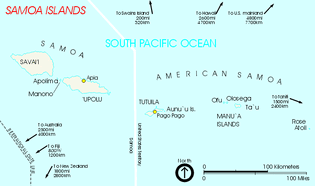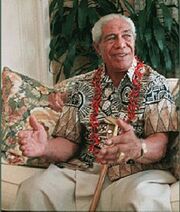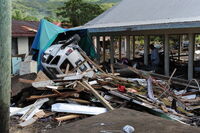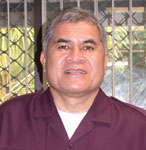| Official languages | English, Samoan |
| Capital | Apia |
| Chief of State | HH Tui Atua Tupua Tamasese |
| Prime Minister | Utu Abe Malae (LPS) |
| Establishment | 20 December 1983 |
| Incorporation into ANZC | 30 March 1996 |
| Population | approx. 155,000 |
| Area | 3,030 km² |
| Currency | Tala (WS$, $, T) before 1996 Commonwealth dollar ($) since 1996 |
| Subdivision of |

The Samoa archipelago
Samoa is an Associate Member nation of the Commonwealth of Australia and New Zealand. It formed as a union government of the Independent State of Western Samoa and the Territory of American Samoa. It remains a two-state federal country, its parts today called Eastern and Western Samoa. Its origins date to late 1983, and it governed itself with near-independence between 1983 and 1997. It surrendered some of its sovereignty to the Commonwealth but maintains a high level of autonomy.
History[]
Background[]
Formerly an independent kingdom, Samoa was divided between Germany and the United States in 1899. The German portion, the larger of the two, was later granted to New Zealand, first as a League of Nations mandate, then as a UN trust territory. It achieved independence as the Independent State of Western Samoa in 1962. American Samoa, the smaller part of the islands, remained a US territory. The two nations shared a common language and culture, but under the influence of different colonizing powers, they began to diverge. Western Samoa remained in the Commonwealth of Nations: its government was based on the Westminster system, and its most popular sports were rugby and cricket. American Samoa's government followed the American pattern of Governor and bicameral legislature, its most popular sport American football. Although the colonial language of both Samoas was English, the West used the Commonwealth standard, the East, the American.
Aftermath of World War III[]
American Samoa was not a nuclear target: while America had colonized it to use as a naval base, all military activity had ceased after World War II except for a small Coast Guard rescue station and an Army reserve center. So the islands were one of the few U.S. polities totally spared the carnage of Doomsday in September 1983. Its economy was strongly linked to the United States; however, a good deal of food was produced locally. Its main industry was fishing, and moreover much of the islands' traditional Polynesian village economy of communal farms remained intact. The massive climate disruptions of the mid-80s put severe strain on both fishing and farming, but American Samoans were able at least to avoid starvation even after their links to the Mainland were severed.
However, with its main trading partner totally debilitated, American Samoa faced economic collapse. Its leaders immediately turned to the west for help. Western Samoa's main partner New Zealand was untouched by the missiles, so the state was well equipped to support its eastern neighbor. Steps were immediately taken to divert American Samoan trade to New Zealand. Even in the post-Doomsday chaos the New Zealand Parliament managed to pass the Samoan Aid Act in November 1983, providing financial and infrastructural aid to both Samoan nations.
Reunification[]
With the USA apparently out of commission, leaders and citizens alike in the East realized that they would have to fend for themselves for the foreseeable future. A partnership between the two Samoas - alike in language and culture, separated by less than a century of colonization - seemed a logical step. Leaders established the Governing Committee for Samoa within months of Doomsday, and it officially began its work on December 20, 1983. The Governing Committee is considered the first of the many international unions that emerged in the aftermath of the world war (see the Geopolitics page).
Nominally, American Samoa remained sovereign US territory. But with no contact received from the States and none expected, American Samoans had no qualms about creating this new governing structure in the face of the emergency. The Committee assumed the powers of a united national government in fact, if not in name.
Contact with USA[]
The first people from the States to arrive at Samoa were small groups of refugees fleeing starvation and civil strife in Hawaii. Some Samoans traveled to the state, but Samoa could do little to help its new labor union-controlled government. Throughout 1984 and 1985, New Zealand emerged as the patron nation for all of the Samoa islands.
Official contact from the US government happened in May of 1984. The American Provisional Administration was established in Hawaii. President Ronald Reagan intended to govern from the Pacific, working closely with America's allies and shoring up its surviving territories. After his death in a plane crash, George Bush came out to replace him. From Hawaii, Bush was able to speak directly to Governor Coleman and send messages to the Samoan people. He visited Pago Pago that July on his way to Australia. American Samoa affirmed its loyalty to the government-in-exile; an APA office was established in Pago Pago by October. However, the Governing Committee was managing an increasing amount of the day-to-day affairs of both halves of Samoa.
Stability[]

Schematic showing the overlapping authority of Samoa and the APA after the 1985 ANZUS order
In 1985, the islands' complex status was hammered out. As the APA met with Australia and New Zealand to strengthen the ANZUS military alliance - the precursor to the ANZ - delegates from the Governing Committee also met with the ANZUS powers. Their challenge was to harmonize Samoa's de facto status as a unified state with American Samoa's legal status as an American territory.
ANZUS Order 011/1985, the Resolution on the Status of Samoa, laid out a plan for a permanent democratic government for the islands. It mandated that the Governing Committee either draft a new constitution for Samoa or prescribe a method for electing delegates to do so. The Order, written largely by Samoan advisers, recommended a bicameral legislature with a lower House based on the Westminster model and an upper House based on the American. Executive authority would be exercised by an elected President and by a Prime Minister chosen by the President on the advice of both Houses. Both Western and American Samoa would maintain separate governments responsible for matters not delegated to the union government. The Order would require ratification by the Samoan people.
Furthermore, in the Order the ANZUS nations pledged to recognize the united government as the legitimate authority over the Samoan Islands. However, the APA retained some authority over American Samoa, which would function as a sort of condominium. The Order clearly divided powers between the united government and the APA. The APA and the US Navy would be primarily responsible for defense, for example. Finally, the united Samoa government was entitled to send an observer to ANZUS meetings.
Samoa's constitution was approved in a referendum in February 1986. It largely followed the ANZUS recommendations, although the title of President was rejected in favor of that of Chief of State (O le Ao o le Malo), the existing title of the head of state in Western Samoa. Samoa held its first elections that May, and the United Fono, the new legislature, met in September near Doomsday's third anniversary. Malietoa Tanumafili, Chief of State of Western Samoa since its independence from New Zealand, easily won the election, confirming his new status in all of Samoa. Considering the plight of other nations, including many in the Pacific, Samoa's post-Doomsday course had been remarkably smooth.
Samoa in the ANZUS Commonwealth[]

Longtime Chief of State Tanumafili talking to an interviewer
Partly due to the presence of the American Provisional Administration, partly through its participation in ANZUS, but mostly through the solid bonds of culture and trade, Samoa's links with Australia and New Zealand were strengthened throughout the late 80s and early 90s. They also remained a crucial part of the APA's governing structure, being located exactly on the line between Aukland and Hawaii.
The islands were stable, but they remained dependent upon aid from New Zealand, and economic opportunities were few. Many Samoans, especially whites, emigrated to New Zealand or Australia during this period. Low birth rates resulting from poor nutrition and the global fallout meant that Samoa's population declined noticeably.
The United Fono renounced all claims over Tokelauan-speaking Swains Island in 1988. The Tokelau Islanders, residents of a New Zealand colony, had long claimed Swains as their own. The USA had colonized the little atoll in the 19th century and grouped it with American Samoa largely out of convenience. The APA did not renounce its claim, and continued to administer Swains from Pago Pago. Thus Swains was paradoxically part of American Samoa, but not part of Samoa.
Also in 1988, the ANZUS allies formed a civil body, called the ANZUS Commonwealth, to oversee the military alliance. The British forces in the Pacific, which had joined the military alliance, were given the status of Associate Member of the new commonwealth. Samoa had also participated in the military alliance, though only as an observer; now its government sought the Associate Member status alongside Britain. This was accomplished in 1990. Samoa seated a representative in the Commonwealth's governing body, called the ANZUS Commission.
In 1991, the American Football League was founded in Pago Pago. The League brought together American Football enthusiasts throughout Oceania. 18 years later, the League is still headquartered in Pago Pago despite frequent proposals to move it to someplace more cosmopolitan in New Zealand or Australia.
Samoa and ANZ[]
By 1994, it was becoming clear that the American Provisional Administration was beginning to outlive its usefulness. A series of setbacks and failures cost the APA support among both its allies and its citizens. On May 1, 1995, George Bush announced the end of the provisional administration. It was clear that the Commonwealth would need to change to match this new reality, and Samoan leaders participated in the ensuing negotiations. A new Commonwealth of Australia and New Zealand, replacing the ANZUS Commonwealth, was proclaimed on 15 August. That November, the United Fono voted overwhelmingly - 88% in favor - to maintain its Associate Member status in the new Commonwealth. It would ratify several more ANZ treaties laying the groundwork for a more robust regional government.
The APA wound down over the next few months. On March 30, 1996, the Stars and Stripes were lowered in Pago Pago for the last time. The APA transferred Swains Island to Tokelau, now a non-self-governing External Territory of the ANZC, on April 22. Swains was the last territory to be administered by the APA, and therefore, it was oddly enough the last piece of territory ever to be governed by the United States of America in the Pacific.
The Chief of State election of 1999[]

Chief of State Tupua in a thoughtful pose
Malietoa Tanumafili had led Western Samoa from colonialism to independence in the 1960s and had guided united Samoa through the aftermath of nuclear war and the transition to ANZC rule. Universally loved in the east and the west, he did not face a serious opponent in the elections of 1986, 1991, or 1996. And when he died in 1999, he clearly had a natural successor in Tui Atua Tupua Tamasese. Like his predecessor, Tupua was a paramount chief, one of only a handful in the country and the only one actively involved in politics. He easily won the election and sailed to re-election in 2004 and 2009.
The Australian press criticized the elections as undemocratic, but New Zealanders were more tolerant of the island state's quasi-monarchy in the context of Samoan culture: to Samoans, the office of Chief of State naturally belongs to the paramount chiefs, though constitutionally it is open to anyone.
The 2009 tsunami[]

Damage on Tutuila
On September 29, 2009, an underwater earthquake in the northern waters of Tonga sent a devastating tsunami crashing into every island in Samoa in four different waves. More than 200 Samoans were killed, several villages were wiped out, and hundreds of families were left homeless, with countless more internally displaced to the high ground on each island. The capital Apia was virtually abandoned for several weeks.
Commonwealth military personnel arrived October 1 on the frigate ANZS Kaitiaki at the request of Chief of State Tupua to maintain order in the disaster area and engage in relief work. Teams also arrived under the auspices of the WCRB and the Hawai'i Marine Militia. The acting head of the Catholic Church, Archbishop Oscar Scheid, led prayers for Samoa. As initial injuries were treated, concerns rose that the lack of food, fresh water, and infrastructure would put many Samoans at risk of disease.
On October 5, Tupua announced that the November elections would go ahead despite the disaster. For the next month and a half, government workers scrupuously worked to ensure that internally displlaced people still living in camps would have access to ballots. Tupua was reelected, and Prime Minister Malae's Liberal Party of Samoa gained seats in the Senate, a sign that voters approved of both leaders' handling of the crisis. By that time, Samoa had mostly secured channels for food and medicine to arrive from New Zealand, and a number of doctors and paramedics had spent time on the islands to stabilize the public health situation. However, thousands remained without permanent homes.
Government[]

Prime Minister Utu Abe Malae
Samoa's government under the 1986 Constitution remains largely intact. It reflects a compromise between the systems of American and Western Samoa.
Samoa, like its fellow associate member Micronesia, has a head of state distinct from the Governor-General of the Commonwealth. (This is distinct from the full members, Australia and New Zealand, which consider the head of the Commonwealth to also be head of state of each nation.) He bears the title O le Ao o le Malo (Chief of State) and is elected by the people to a five-year term. Malietoa Tanumafili had been elected by the Fono of Western Samoa for life, and the change was meant to adhere to principles of democracy. In fact, however, the Chiefship is still monopolized by Samoa's royalty.
The Chief of State is responsible for carrying out Samoa's laws in accordance with the laws and constitution of the Commonwealth, though his actual power is largely ceremonial. His royal-sounding title (His Highness the Chief of State) does not confer any particular privileges, but culturally he carries a great deal more pomp and prestige than his counterparts in Australia and New Zealand.
The Fono itself is bicameral, with the lower house the more powerful and responsible for presenting a candidate for Prime Minister to the Chief of State. The upper house, the Senate, is also elected, but has more limited powers. Most notably, the Senate has veto power over bills from the lower house, Prime Ministerial candidates, and certain appointments by the Chief of State and PM. The Prime Minister as head of government carries out most of the day-to-day administration of the state. The current PM is Utu Abe Malae (LPS), a conservative from Manu'a in the former American Samoa. Like Tupua, Malae is of chiefly rank, though not as high. He has served since 2006.
Samoa is also a federal country. Its two halves, Eastern and Western Samoa, continue to manage local affairs according to their prewar systems. All officials must act in harmony with the laws of the United Fono, as well as the Commonwealth. Each half also has an independent judiciary. The United High Court consists of the Supreme Court of Western Samoa and the High Court of Eastern Samoa sitting together.
At the village level, the traditional fono retains a great deal of local authority.
Samoa's political spectrum has come to be dominated by the same 3 coalitions that operate at the national level: conservative, labour, and green. The conservatives are represented by the Liberal Party of Samoa (LPS). Samoa's local labour party is the Human Rights-Labour Party (HRL), a descendent of the Human Rights Protection Party founded in 1979. The green movement arrived in 1998 with the creation of the Fanua Party (FP), which has grown more influential over the years, though it has never held a majority in the Fono. Samoa also has a long history of nonpartisanship that is still reflected today. Both Chiefs of State have been resolutely nonpartisan, and many members of the Fono, especially the Senate, are independents.
Language[]
Samoan is the official language of the state and, consequently, is one of the official languages of the ANZC. It is spoken not only throughout the islands, but also by a large diaspora community in New Zealand and Australia, with a few small communities in the neighboring islands of Fiji, Tonga, and Kiribati.
English is the Commonwealth-wide language and has a long history on Samoa. Samoan English has some distinct dialectical features but has yet to be studied in-depth; it is mainly a second language for most Samoans. Samoans' spelling of English is noteworthy: both American and British spellings are officially used. 25 years of cultural and educational influence has led to a decline in American spellings in Eastern Samoa, but they are still used, especially by older writers. Eastern Samoans used to American spellings have a tendency to hypercorrect, trying to correct for British spellings even when it is not necessary, resulting in an inconsistent orthography that is jokingly called "Samouan." It is common to see mistakes like "coulors" on signs in the east.
Flag[]
The Samoan flag was designed in 1984. It consists of a series of white stars on a blue field in the form of a rough map of the islands, with the three main islands represented by large stars, the islets by small ones. It recalls the flags of both Western Samoa and the USA. A small star representing Swains Island at the top of the flag was removed in 1988. Uninhabited Rose Atoll was never included.
See also[]
| |||||||||||||||||
| ||||||||||


